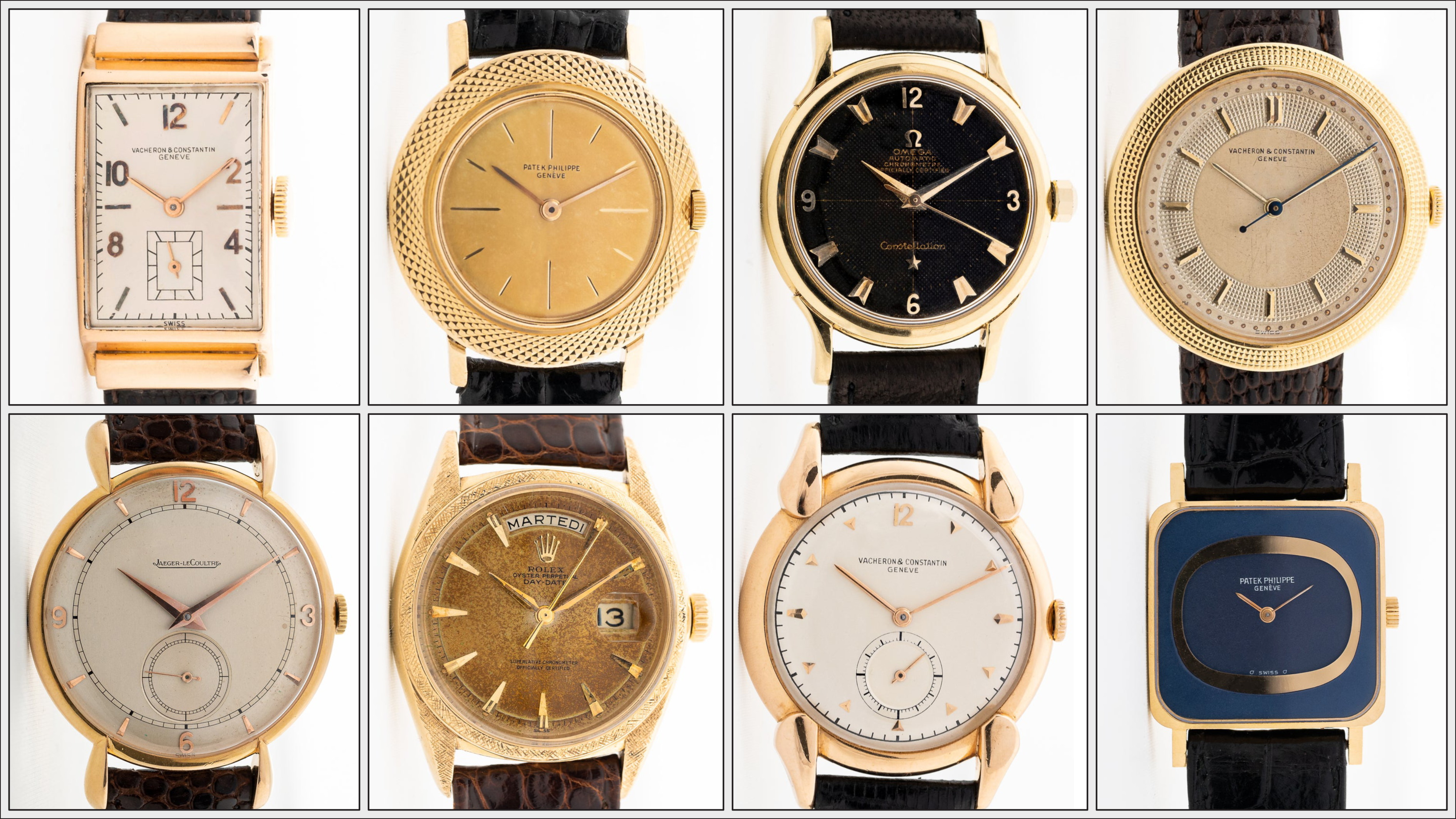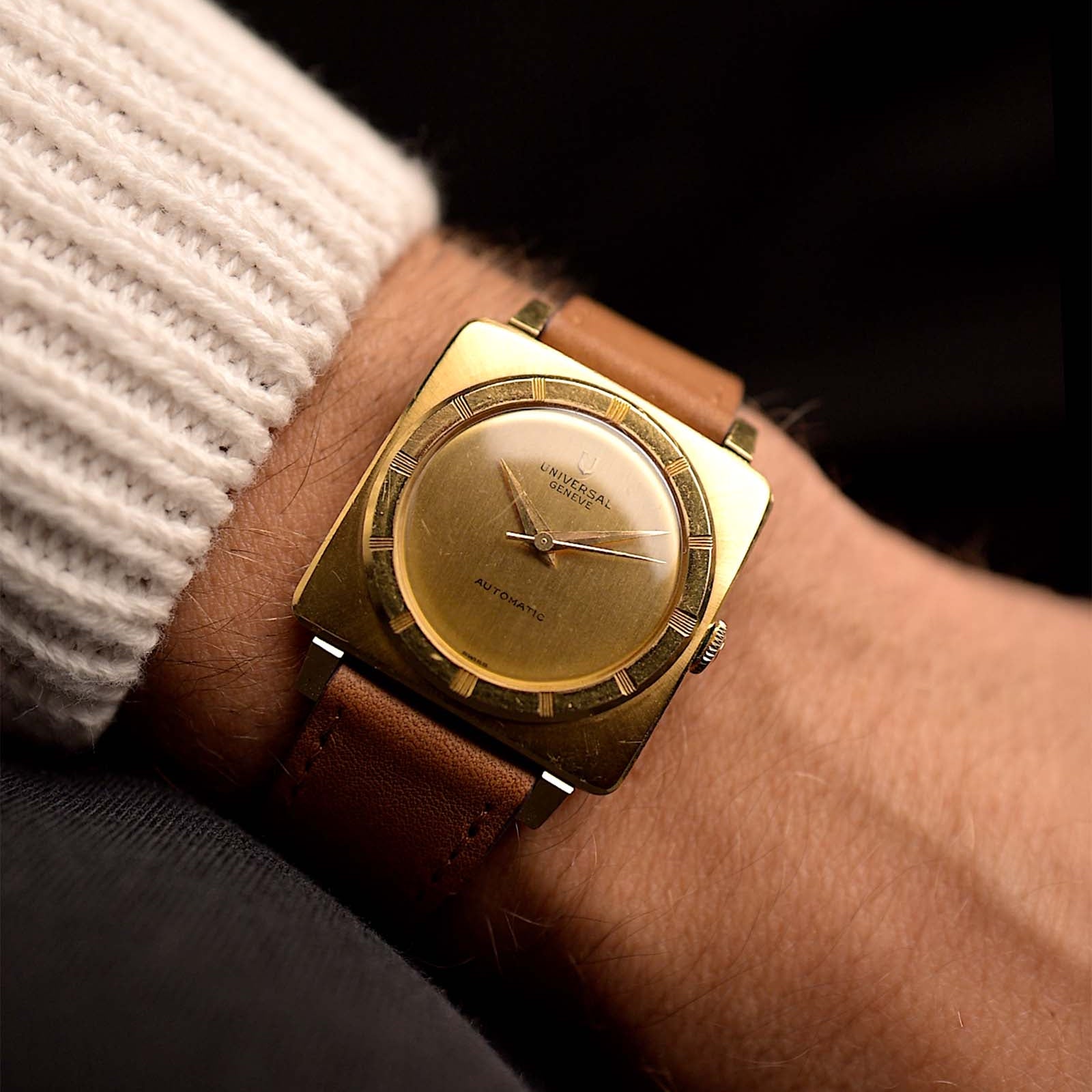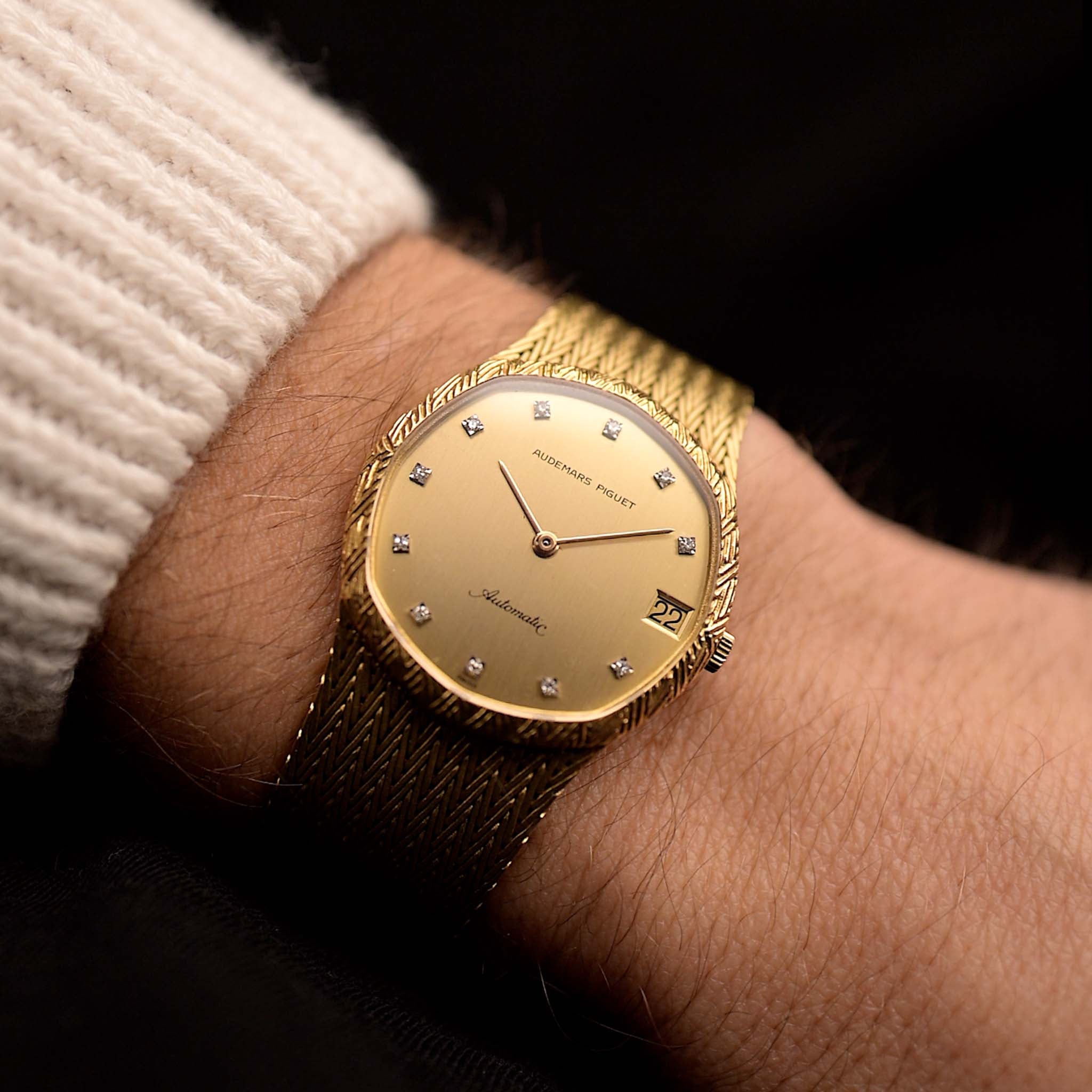This is the first out of a couple guides on the history and designs of Swiss watch case makers from the last Century. Third party suppliers have been the backbone of the industry for a long time and to better understand the world of vintage watches we got to understand case makers and their approach to the craft. This is a non-exhaustive list highlighting some of the most influential manufacturers of their time (which shall not undermine any of the left-out craftsmen). Depending on the origin of the case and the material you will find six different hallmark types - key, shield, hammerhead, hammer & handle, crossbow (silver), and FFBA (silver). Key and shield indicate gold and platinum cases with a thickness of above 3mm (Key) or below (Shield).
November 22, 2023
The Guide to Watch Case Makers - The Genevan Key

Marcus Siems @siemswatches
Collector, Author, Data Analyst
Case Maker Guide - Part I Geneva - Part II La Chaux-de-Fonds - Part III Other -
This is the first out of a couple guides on the history and designs of Swiss watch case makers from the last Century. Third party suppliers have been the backbone of the industry for a long time and to better understand the world of vintage watches we got to understand case makers and their approach to the craft. This is a non-exhaustive list highlighting some of the most influential manufacturers of their time (which shall not undermine any of the left-out craftsmen).
It goes against our modern perception of brands and production mechanics but a good 70 years back watchmakers weren't producing their own cases! In like at all... Much rather case makers were sending their ideas, designs and prototypes to watch manufacturers, which on their end decided what case to utilize. An important conclusion from that procedure has been that from time to time the same case design ended up in the catalogue of several manufacturers.
 Sometimes you will find the same case design from several different watch brands. Here are three examples of the "Top-Hat" reference 1450 from Patek Philippe (left) and an identical case clone from IWC (right) as well as a compatible design without hooded lugs from Audemars Piguet (middle; examples with hooded lugs are known, too). All are genuine cases for the respective brands by Markowski (key #8). Photos Courtesy of Monaco Legend Group, Antiquorum, & Connoisseur of Time.
Sometimes you will find the same case design from several different watch brands. Here are three examples of the "Top-Hat" reference 1450 from Patek Philippe (left) and an identical case clone from IWC (right) as well as a compatible design without hooded lugs from Audemars Piguet (middle; examples with hooded lugs are known, too). All are genuine cases for the respective brands by Markowski (key #8). Photos Courtesy of Monaco Legend Group, Antiquorum, & Connoisseur of Time.
However, with this third-party powered machinery it remained important that the of each part within the process could be traced back. First, for customers (and the assembling brands themselves) to transparently trace back good and bad quality. Second, for the case makers to trademark their creations.
Thus, case hallmarks - or Poinçons de Maître - were introduced. Literally translating to punch of the master they standardized and documented the third-party supply chain within Switzerland.
You can find an introduction to the Swiss hallmark system here. Goldammer Vintage Watches video by Felix Goldammer.
You can find the case makers hallmarks inside the case back*. Depending on the origin of the case and the material you will find six different hallmark types - Key, Shield, Hammerhead, Hammer & Handle, Crossbow (silver), and FFBA (silver)[1-2]. Key and shield indicate gold and platinum cases with a thickness of above 3mm (Key) or below (Shield) but made in Geneva for some of the most prestigious brands. The Hammerhead (and Hammer with Handle) indicates gold and platinum cases made in Switzerland but outside of Geneva. FFBA and Crossbow can be found on silver cases made in Neuchatel/Jura or outside, respectively.
 Pictograms of the 6 Swiss hallmarks - or Poinçons de Maître - found inside watch casebacks. Photo Courtesy of David Boettcher, VintageWatchStraps.
Pictograms of the 6 Swiss hallmarks - or Poinçons de Maître - found inside watch casebacks. Photo Courtesy of David Boettcher, VintageWatchStraps.
Thus, to understand vintage watches we need to take a closer look at the supply chain. What cases and designs were made by whom? What type of cases and developments were put forward? We thus start our guide on watch case makers in Geneva - the epicenter of the horological world - and want to showcase some examples of their creations:
 A stunning vintage 1950s Omega in a Jumbo case (37.5mm) ... made by Wenger in Geneva (key #1). Photo Goldammer Archives.
A stunning vintage 1950s Omega in a Jumbo case (37.5mm) ... made by Wenger in Geneva (key #1). Photo Goldammer Archives.
The Geneva Key (as well as other hallmarks on watches) became mandatory with the Swiss Precious Metal Act from 1933. To better control the trade of precious metal all jewelers and case makers had to file Poinçons de Maître with the Central Bureau for the Control of Precious Metals in Bern by July 1st 1934[1]. However, the hallmark system on watch cases was established during the mid 1920s potentially on a voluntary basis. You can already find registered Poinçons from around 1925 on exported cases[1].
Geneva Key No. 1 - Wenger (1934-92)
Background. The manufacture of Wenger is one the most prestigious and established case makers around. Established in 1912 with a registered trademark already from 1920 they made some of the best pocket- and wristwatch cases for several Swiss brands[3]. Alongside their impeccable precious metal cases Wenger established the "acier inoxidable" process to improve steel-made watch cases[3].
Style. It is always hard to gloss over so many models but their style can potentially best be described through their several intricate case constructions as for example for many calendar watches as well as the first Reverso cases (as well as several 1930s/40s rectangular pieces).
Examples. Patek Philippe 2499 (from 2nd series), Jaeger-LeCoultre Reverso, Vacheron Constantin Teardrop Lugs, Omega Constellation C-Shape
 Several examples of Wenger-made cases (key #1). Photos Courtesy of Sotheby's, Brevet Watches, Collectability, & Goldammer Archives.
Several examples of Wenger-made cases (key #1). Photos Courtesy of Sotheby's, Brevet Watches, Collectability, & Goldammer Archives.
Geneva Key No. 2 - Baumgartner (1934-73)
Background. Little is known about the manufacture of Fritz Baumgartner during its early days. However, one important milestone in their history has been the construction of the first dive wristwatch case - the Omega's 1932 Marine[4-5] as well as cases for Patek Philippe's first automatic watch, the ref. 2526[3].
Style. Even though the name Baumgartner is associate with some of the most important early tool-watches their style also expanded into very filigree designs with sophisticated lines and roundings.
Examples. Omega Marine, Patek Philippe 2526, Patek Philippe Ellipse (ref. 3546), Omega Seamaster, Universal Geneve Polerouter, Patek Philippe Disco Volante, IWC DeLuxe
 Several examples of Baumgartner-made cases (key #2). Photos Courtesy of Omega Archives & Goldammer Archives.
Several examples of Baumgartner-made cases (key #2). Photos Courtesy of Omega Archives & Goldammer Archives.
Geneva Key No. 3 - Unknown
Background. The case maker that hides behind the key #3 is unknown so far (to us at least)[1]. Nevertheless, we can find that this particular Poinçon can be found on several mid-Century Jaeger-LeCoultre watches.
Style. Mid-Century Jaeger-LeCoultre.
Examples. Jaeger-LeCoultre Memovox, Teardrop Lugs
 Two example Jaeger-LeCoultre watches with cases made by the rather mysterious key #13. Photos Courtesy of Goldammer Archives.
Two example Jaeger-LeCoultre watches with cases made by the rather mysterious key #13. Photos Courtesy of Goldammer Archives.
Geneva Key No. 4 - Antoine Gerlach (1934-77)
Background. The manufacture Antoine Gerlach might among collectors be best known for making the first (precious metal) cases for Patek Philippe's Calatrava ref. 96 - the original Calatrava. But they also made cases for the "Padellone" Patek Philippe ref. 3448 as well as Omega's semi-Pie-Pan dialed Constellation models of the 1950s/60s. One of Gerlach's most prominent features is a waterproof snap-on case back.
Style. Futuristic and sport-chic, thin and waterproof.
Examples. Patek Philippe ref. 96 (ref. 570), Omega Constellation (ref. 2799), Patek Philippe Gilbert Albert "Ricochet" pocket watches
 Several examples of Gerlach-made cases (key #4). Photos Courtesy of Christie's, Phillips, & Goldammer Archives.
Several examples of Gerlach-made cases (key #4). Photos Courtesy of Christie's, Phillips, & Goldammer Archives.
Geneva Key No. 5 - Georges Croisier / Jean-Pierre Ecoffey (1934/1971-90)
Background. The case maker Georges Croisier started his business approximately around 1870. Croisier mastered the "Staybrite" technique to craft high-end steel watches at the time and was thus the case maker to some of the most intriguing steel watches as for example 3 of the 4 steel Patek Philippe ref. 1518[3]. In 1971 the manufacturer was taken over by Jean-Pierre Ecoffey, one of the leading bracelet makers at the time.
Style. Simplistic design with masterful finishing, particularly on steel. Prominently featured in Vacheron Constantin and Patek Philippe models.
Examples. Patek Philippe ref. 1518 steel, Vacheron Constantin Disco Volante 4786,
 Several examples from Vacheron Constantin and Patek Philippe of Croisier-made cases (key #5). Photos Courtesy of Phillips, Monaco Legend Group, & Goldammer Archives.
Several examples from Vacheron Constantin and Patek Philippe of Croisier-made cases (key #5). Photos Courtesy of Phillips, Monaco Legend Group, & Goldammer Archives.
Geneva Key No. 8 - Markowski (1934-63)
Background. Francois Markowski (first recorded in 1921[3]) is a very central figure in the design heritage of Patek Philippe. Several shaped designs can be traced back to the Genevan case maker. Overall, the execution of these pieces is outstanding in terms of the complexity of the case architecture.
Style. Rectangular and naturalistically shaped watches with complicated constructions and domed crystals.
Examples. Patek Philippe 1450 "Top-Hat", Patek Philippe Gilbert Albert ref. 3424, Patek Philippe 2442 "Marilyn Monroe", Patek Philippe Comet Series
 Several examples of shaped Markowski-made cases (key #8). Photos Courtesy of Phillips, Monaco Legend Group, & Ronak Madhvani (@roni_m_29).
Several examples of shaped Markowski-made cases (key #8). Photos Courtesy of Phillips, Monaco Legend Group, & Ronak Madhvani (@roni_m_29).
Geneva Key No. 11 - Borgel/Taubert (1934-74)
Background. The story of the Taubert cases does actually begin before the Precious Metals Act of 1933. The company was originally founded in the 19th Century by Fancois Borgel, an ingenious inventor that spearheaded the modern case making: In 1892 he patented the first waterproof watch case with screw-down case back[3]. The (British) patent was later taken out by Hans Wilsdorf (via Spillman) and integrated into the original Rolex Oyster case design.
You can still find the "F.B. [Key]" trademark inside case backs long after the company was sold to the Taubert family in 1924 by his daughter[6].
Style. Sporty cases with a focus on water-tight case backs. You'll find several different designs but often with down-turned lugs (like Tasti Tondi) or faceted lugs with a stepped bezel case. One of the "you know it when you see it" type of archetype.
Examples. Movado M95 chronograph, Rolex Oystercase Origin, Patek Philippe 1463 Tasti Tondi, Patek Philippe 565
 Several examples of Taubert-made cases (key #11). Take a closer look at the downturned lugs (left, Tasti Tondi) and the faceted lugs with stepped case (bottom right, Movado M95). Photos Courtesy of Monaco Legend Group, Antiquorum, & The Time Curator.
Several examples of Taubert-made cases (key #11). Take a closer look at the downturned lugs (left, Tasti Tondi) and the faceted lugs with stepped case (bottom right, Movado M95). Photos Courtesy of Monaco Legend Group, Antiquorum, & The Time Curator.
Geneva Key No. 12 - Genex (1940-85)
Background. Among many features the horological powerhouse Rolex has been starting to move production "in-house" very early - actually before this even became a (un)thing. The brand "Genex" is one aspect for that endeavor. Established as a trademark already in 1920, Genex has been one of the many Geneva based Rolex case makers. I'd thus like to name further Genevan Key hallmarks #7 (Degoumois) & #39 (Hertig) as additional case makers for Rolex (mainly for the Cellini collection).
Style. The Oyster case.
Examples. Rolex Day-Date, Rolex Oyster Perpetual Gold
 A selection of Genex-made cases of Rolex (key #12). Photos Courtesy of Antiquorum & Goldammer Archives.
A selection of Genex-made cases of Rolex (key #12). Photos Courtesy of Antiquorum & Goldammer Archives.
Geneva Key No. 23 - Eggly & Cie (1934-90)
Background. The Eggly manufacture is a quite interesting case. Making high-end cases for the likes of Vacheron Constantin, Patek Philippe and Audemars Piguet - the holy trinity.
Style. Think of shaped watches and interesting lug architecture enshrined into some of the most daring and architectural designs of the last Century.
Examples. Vacheron Constantin Cornes de Vaches, Patek Philippe Calatrava 2407, Audemars Piguet Ellipse
 Several examples of Eggly-made cases (key #23). Photos Courtesy of Audemars Piguet Heritage Department & Goldammer Archives.
Several examples of Eggly-made cases (key #23). Photos Courtesy of Audemars Piguet Heritage Department & Goldammer Archives.
Geneva Key No. 28 - Ateliers Reunis (1964-2017)
Background. Ateliers Reunis first appears on record around 1964 (previously Marcel Pugin) and is probably best known as the modern in-house (since 2000) case maker for Patek Philippe[3]. Patek Philippe acquired the factory in 1975 but continued to supply cases to other brands as well.
Style. Classic and elegant - but often with a little extra (shape)... The mullet among the workshops**.
Examples. Patek Philippe 3970, Patek Philippe Nautilus 3700, Patek Philippe Ellipse 3603 Beta21, Patek Philippe Calatrava 3923
 Some example creations from Ateliers Reunis (key #28). Photos Courtesy of Antiquorum, Christie's, Monaco Legend Group, & Goldammer Archives.
Some example creations from Ateliers Reunis (key #28). Photos Courtesy of Antiquorum, Christie's, Monaco Legend Group, & Goldammer Archives.
* Well, inside all case backs made from precious metal as different rules applied for steel cases.
** That's a positive!
References
[1] Swiss Poincons de Maitre; David Boettcher, VintageWatchStraps;
https://www.vintagewatchstraps.com/swisspdm.php
[2] Vintage Watch Hallmarks Explained; Felix Goldammer, Goldammer Vintage Watches;
https://www.youtube.com/watch?v=m8Bpj0puQbE
[3] The Key to Master Case Makers for Patek Philippe; Tania Edwards, Collectability;
https://collectability.com/learn/the-key-to-master-case-makers-for-patek-philippe/
[4] 1932: Omega Marine, the First Dive Watch; Omega Chronicles;
https://www.omegawatches.com/chronicle/1932-wet-and-dry-precision
[5] Omega Marine: First Dive Watch; David Boettcher, VintageWatchStraps;
https://www.vintagewatchstraps.com/blogomegamarine.php
[6] Borgel vs. Baumgartner Breakthrough: The FB mystery solved at last; David Boettcher, WatchUSeek Forum;
All rights on text and graphics reserved to the Author.




























1 comment
Guten Tag
Habe eine IWC und die hat die Punze Genfer Schlüssel mit der Nummer 9
Haben Sie zur Nummer 9 auch einen Hersteller ??
Schöne Grüße
Fabian
Leave a comment